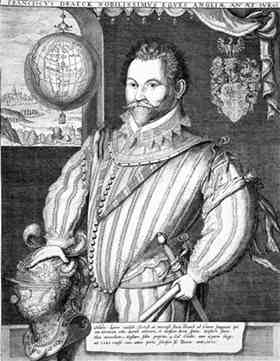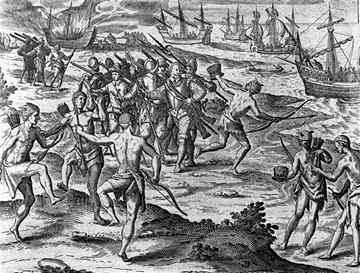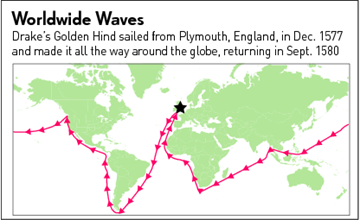Francis Drake was the first Englishman to sail around the world, completing the three-year journey in 1580. Upon returning home, his ship loaded with treasure, Drake was knighted by Queen Elizabeth I.
 Decades earlier, a Portuguese crew under Ferdinand Magellan became the first one ever to circle the globe. Yet Magellan died along the way in the Philippines in 1521.
Decades earlier, a Portuguese crew under Ferdinand Magellan became the first one ever to circle the globe. Yet Magellan died along the way in the Philippines in 1521.
Drake (1540-96) survived the punishing voyage to earn his courageous place in nautical history. He was a skillful navigator who beat back the Spanish fleet over many expeditions in the late 16th century.
"Drake was considered either a great privateer or a great pirate, depending on which side you were on," said William Cogar, CEO of The Mariners' Museum in Newport News, Va., and a former history professor at the U.S. Naval Academy.
British history often portrays Drake as a brave leader who extended the nautical reach of Elizabethan England against its colonial rivals Spain, France and Portugal. Drake clearly overcame many hardships, from raging storms and mutinies to plain starvation and illness.
To Spaniards, Drake was a rogue buccaneer who attacked their undefended vessels and looted hard-won riches. They called him El Draque, or Draco the Dragon. Some saw him as a wizard with devilish powers.
So many fantastic myths grew up around Drake's legend that scholars find it hard to separate facts from folklore, says Jennifer McNabb, a history professor at Western Illinois University.
"Drake was certainly an accomplished sailor and strategist and politician. At the same time, it's hard to escape the sense that he was a plunderer," she told IBD. "As for whether he was a scoundrel or a hero, he seems to have been a bit of both."
The Start
Drake was born into a large family in Devonshire, England. He honed his seafaring skills as a teen, and in 1567 he became captain of a commercial trade ship in the Caribbean islands. He served under his relative John Hawkins, a renowned sailor and illicit slave trader.
The next year, Spanish ships attacked Hawkins' fleet. He and Drake escaped with their ships, but they lost five other vessels, erasing all profits from the trip.
Returning to England, Hawkins and Drake were denied financial redress by the government. That painful loss fueled Drake's enmity and desire for revenge against the Spanish. He and Hawkins vowed to wage marauding expeditions against Spanish commerce along the shores of Central and South America.
These two crafty sailors became known as sea dogs. They competed for the favor of the capricious Queen Elizabeth. She played their successes and charms against the best efforts of Walter Raleigh, another talented courtier.
 By the early 1570s, Drake was again prowling the warm waters of the Caribbean. He made several forays into the West Indies, attacking Spanish shipping lanes and raiding Spanish-controlled ports.
By the early 1570s, Drake was again prowling the warm waters of the Caribbean. He made several forays into the West Indies, attacking Spanish shipping lanes and raiding Spanish-controlled ports.
In 1573, he captured a Spanish mule train in Panama that was hauling 20 tons of Peruvian silver and gold to King Philip II of Spain.
That success led Queen Elizabeth to sanction Drake in 1577 as a privateer on her behalf. This meant she would fund his long voyages.
In return, he brought back vast riches plundered from Spanish colonies — jewels, precious metals, coins and exotic spices.
Drake's greatest adventure involved his harrowing trip to the Pacific Ocean. He was seeking Spanish treasure on the coast of Peru.
One of his ships was destroyed in the violent ocean passage around Cape Horn, at the tip of South America. Another ship missed a rendezvous and had to turn back.
"God, by a contrary wind and intolerable tempest, seemed to set Himself against us," he wrote in his log.
Drake emerged into the Pacific with just one ship, the Golden Hind.
Yet his fearless men pressed on with their plan to raid Spanish ports on the South American coast.
In 1579, Drake captured a Spanish ship off Ecuador. The lucrative take included 26 tons of silver bars, 13 chests of silver coins, and 80 pounds of gold and jewels.
The dazzling payload prompted Drake to seek a speedy route back to England. He sailed up in search of a fabled Northwest Passage that was said to stretch eastward through Alaska and Canada.
Yet frigid waters and storms blocked any progress. The ship had to winter off the Pacific Coast.
The exact location of Drake's Bay on that rocky, foggy coastline has been a point of debate ever since. Some claim it was in Northern California, others in Oregon.
Wherever they landed, Drake's men knew they had to sail westward over the Pacific before crossing the Indian Ocean to get home.
The sailors spent over a month repairing the Golden Hind and storing supplies. They were helped by friendly Coast Miwok natives.
Off to sea, the ship reached Indonesia's Spice Islands, where it ran aground on a reef. The shipmates freed themselves by dumping some cargo overboard.
 When the Golden Hind reached England, the Spanish ambassador urged Elizabeth to hang Drake as a pirate and thief. But the queen was eager to build her own empire. She shot back that Drake's actions were a fair recourse for prior Spanish incursions into Ireland and England.
When the Golden Hind reached England, the Spanish ambassador urged Elizabeth to hang Drake as a pirate and thief. But the queen was eager to build her own empire. She shot back that Drake's actions were a fair recourse for prior Spanish incursions into Ireland and England.
Rather than hang Drake, Elizabeth made him a vice admiral and top naval adviser. Suddenly he was England's political agitator and nautical presence in the New World.
Drake's ascent on the world stage represented the rise of England's emerging Protestant empire against its more established Catholic neighbors, Cogar notes.
"Drake helped define England as a less powerful upstart country against the mighty Spanish empire," the historian said.
Drake was appointed to Parliament and became the mayor of Plymouth, England. Yet he couldn't resist the lure of the high seas for long.
He returned to his ship in 1585 and spent the rest of his life warring with the Spanish fleet.
The most famous naval clash for Drake and Hawkins came in the spring of 1587, when they attacked the port of Cadiz, Spain, and sank, burned or hauled 37 Spanish ships.
This attack on Cadiz hobbled the Spanish Armada's planned invasion of the English Channel, set for that summer. Drake joked about "singeing the beard of the king of Spain."
Spain's Wane
The raid weakened Spain's feared onslaught. When the Armada did attack in 1588, it lost to England and took down Spain's empire with it.
In 1595, Drake set off with Hawkins for one last failed mission to the West Indies. Hawkins soon died near Puerto Rico. The next year, Drake died of dysentery off the coast of Puerto Bello, Panama. He was buried at sea in a lead casket that has never been found.
"Drake seems to have been a master strategist and risk taker," McNabb concluded. "He remains a fascinating figure to this day because his achievement is so closely identified with the nascent phase of British imperialism."
Author: J. Bonasia | Source: Investor’s Business Daily [December 22, 2010]